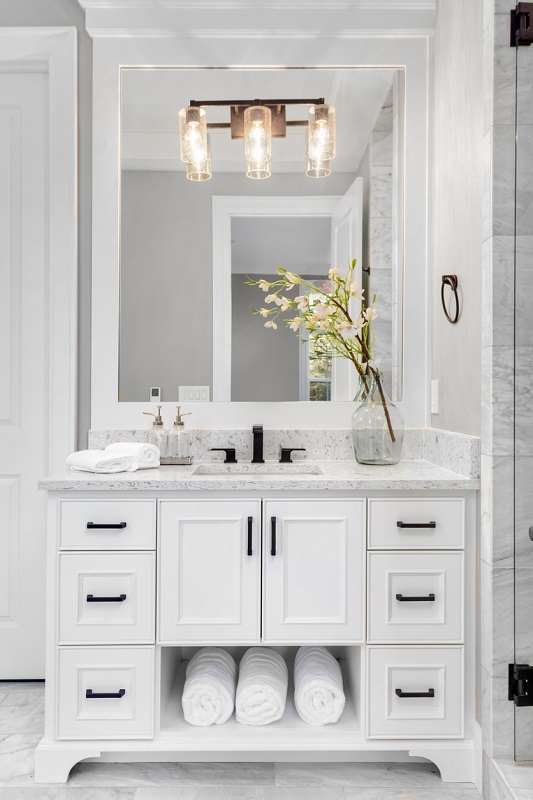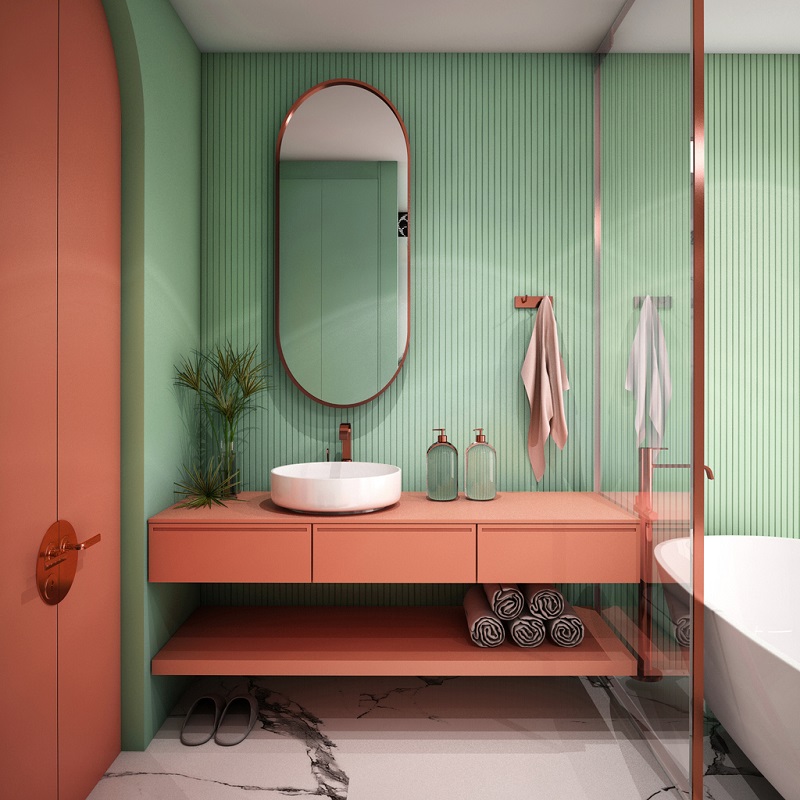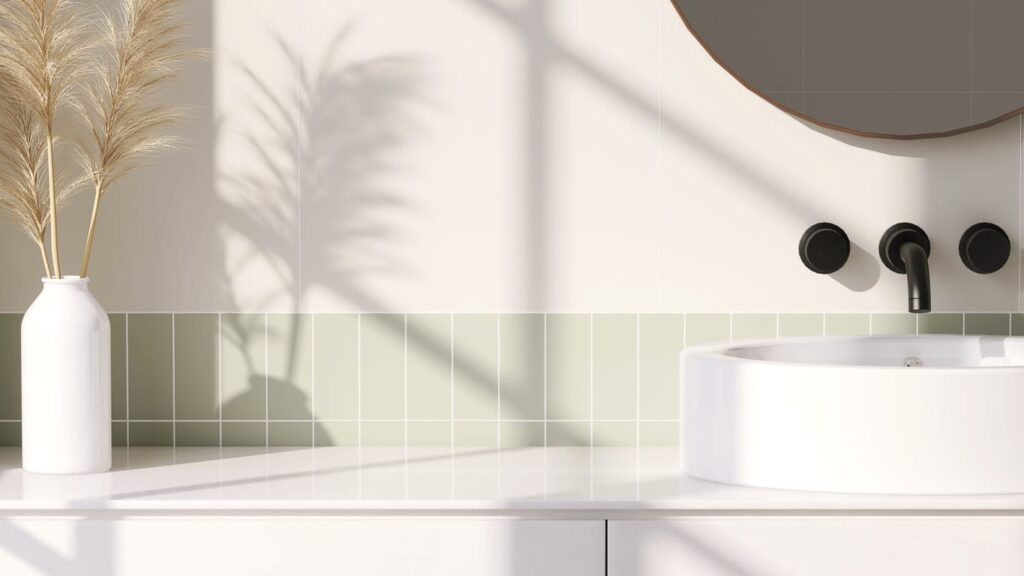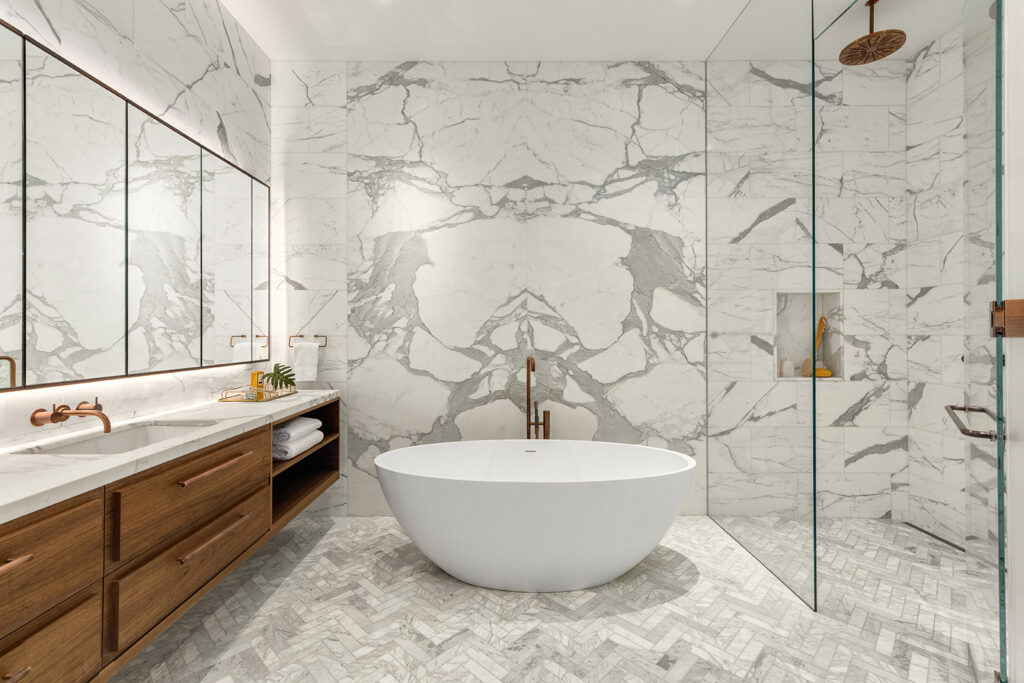One-Piece vs Two Piece Toilet – Pros and Cons- 2025 Expert Guide
When upgrading your bathroom, one of the most important—and often overlooked—decisions is choosing between a one-piece or two-piece toilet. While
A bathroom vanity is an essential aspect of any bathroom and understanding it’s size and dimensions is key to finding the right one for your home. A bathroom vanity has a standard height of 30-36 inches, a depth of 20-21 inches and a wide variety of widths depending on the size of your bathroom. Today we will discuss the standard heights of a bathroom vanity to see which is the right fit for you.
| Vanity type | Height information |
| Standard | 32 inches |
| Comfort | 36 inches |
| Vessel | 29 – 30 inches |
| Floating | 25 – 26 inches |
| Backsplash | Customizable |

The standard height of a bathroom vanity is 32 inches or around 2.5 feet. This height has been the standard height for decades and it is very prevalent in older homes. 32 inches is considered to be the best option for large families, especially for those with small children as it provides a tall counter-top but still can be accessed by those of short to medium stature. Similarly, this is the standard bathroom vanity height for other businesses such as hotels and business offices for the exact same reason that they are easily accessible to people of varying builds and heights. For disabled individuals, a maximum vanity height of 34 inches is recommended as it allows those with wheelchairs easy accessibility and additional support if necessary.
When choosing the standard height for your vanity, always consider the foot traffic of this vanity, the plumbing location and it’s proximity to existing features such as decorative trims, electrical switches and outlets. Remember that plumbing and outlets can be difficult and time consuming to move so choose a vanity that works with these plug-ins.
Not to be confused with standard height, comfort height refers to vanities that are much taller, allowing for easy accessibility without the need to bend down or exert yourself. The comfort height for a bathroom vanity is 36 inches or 3 feet. As this height provides more comfort for the user, it is more common today in newer home designs and is becoming the de-facto norm in many cases.
Additionally, comfort height vanities match up with the standard height for most kitchen countertops, which provides both accessibility and ease of use. However, since these vanities are ergonomically designed for medium to tall individuals, it is recommended that you use stools or a step for younger children so they can reach the top.
Vessel sink bathroom vanity heights are much lower than the standard height so they can accommodate for the extra height of the vessel sink. The purpose of these vanities is not only to provide an accessible countertop but also provide a base for the vessel sinks so that it is much easier to access the sink itself.
The comfort height for a vessel sink vanity is 29-30 inches with a standard height for these same vanities floating around 25-26 inches. For the purposes of installation, keep in mind that vessel sinks themselves will add an additional 5-6 inches.

A floating bathroom vanity is a vanity that is secured at a specific height essentially “floating” the vanity. This provides a vanity that can be installed at both a comfort or standard height level while freeing up space from the bottom of the vanity which provides more installation freedom for the vanity itself. In addition to providing more space, a floating vanity also attains a more modern and contemporary look compared to the traditional vanity, making it ideal for small bathrooms or those in need of additional space.
However, while floating vanities provide installation flexibility, keep in mind that you will have reduced storage space compared to traditional vanities. Also, it is important to maintain and check on the integrity of the bolts you have installed with the vanity to ensure that it is secure as it does not have a grounding base to rest on.

Backsplash height is not necessarily a vanity but instead refers to the height of a buffer zone that is installed between your vanity and your wall, which protects your wall from the water of your sink and eliminates mold or mildew buildup. A backsplash is typically constructed from glass, tile, and natural stone, but the possibilities are endless. The great thing about backsplash is that the size of the area is up to you, allowing for a great deal of aesthetic customization, you can install an area of 3-4 inches or cover your entire wall-it’s up to you.
Backsplash allows you to use an attractive material like natural stone or glass which is aesthetically pleasing while protecting your walls from the backsplash of your sink. If backsplash is appealing to you, consider the cost of the material you want and the size of the backsplash zone before installing. Keep in mind that a vanity without a backsplash zone pre-installed will provide you with a greater deal of flexibility in install as it is quite simple to install a backsplash yourself.
Vanity height is not the only factor to consider when choosing the right bathroom vanity. When it comes to bathroom vanity depth, the standard is anywhere from 20 to 23 inches, with 21 being the average. To take this measurement, start from the front of your cabinet to its rear. Before buying the bathroom vanity, confirm first that it is deep or shallow enough for your bathroom.
Besides making sure that your vanity aligns well with your bathroom, you should take a look into certain trends that might inspire you. Some will not be applicable to your bathroom because of its size or the style you prefer, but they could give you good ideas.
Floating is a recent trend that helps to create a modern look by suspending your vanity. This frees up foot space below and creates more room for additional storage. Floating vanities are paired with simple natural wood or textured finishes to truly bring out the material’s beauty.
In a bathroom, space is always a premium, so opt for more shelving whenever possible. Display your shelves proudly, and although it may seem strange to display everything for your guests, the tidy and organized aesthetic will offset this.
With the modern aesthetic, always remember that less is more. Clear up your countertop, remove the clutter, and opt for your fixtures to take prominence. The result is a simple but sleek-looking bathroom environment, especially with the minimalist vanity.
Wood is very popular for a reason: creating a sleek spa look that adds natural serenity to a space. The beauty is that natural wood fixtures and accessories pair well with any aesthetic. So if you want modern, contemporary, or classic designs, consider adding a breath of life to the space.
Experimentation can create truly beautiful spaces. Add industrial influences by using recycled wood, old metal, or anything that appeals to your sensibilities. Ensure the space feels lived in and pair it with marble, concrete, or natural stone to create a unique aesthetic.
Marble is a classic for a reason: creating an elegant and clean environment. Pair your marble vanity with gold, brass, or chrome trimmings.
Many homeowners will overlook the possibility of adding an extra height to your vanity and making your bathroom look even better. This can be especially useful for smaller vanities as you could make it look larger with simple tricks. With increased height, you can achieve the floating effect of your vanity.
Many other things are there to consider when adding a new vanity or changing the existing one.
Ensure that you have the exact measurements of your space to give you limitations and space out your vanity appropriately. Limits are important so that you don’t accidentally overcompensate and select a vanity that is too large.
Whenever possible, consider your original layout. Remodels and moving fixtures can be quite expensive, so plan around your existing layout whenever possible.
Consider your household and ask yourself who would be using the vanity. Try to find a middle ground to satisfy everyone in your household.
Remember that the material for your vanity will see heavy humidity and use, so be sure to select a durable material that can last through anything.
This will depend on your household and how many people you see using your vanity. Typically, for a regular bathroom, a single vanity is enough. A double vanity is advised for a large or master bedroom, but this will depend on the size of your bathroom.
Bathrooms always need as much storage as possible, so finding new ways to store items is necessary.
You can install your own bathroom vanity, but make sure you follow these steps to install it properly:

However, if you’re interested in finding the best option for your vanity or considering customizing it so it fits your bathroom perfectly, it would be best to hire a professional as this is a bit more complicated than just installing a purchased bathroom vanity.
When it comes to bathroom vanities, there are many options for you to choose from. Although your preferences are crucial, don’t ignore the recommendation from this article. Measure the height and depth of your bathroom vanity, and spend some time researching the trends to see if something else caught your eye. Lastly, consider whether this is something you can do on your own or you’d benefit more from hiring a professional.

Eric is the founder and president of Badeloft USA. He has been the president of Badeloft’s US division for over ten years and oversees all marketing and branding aspects of Badeloftusa.com.
His expertise lies in small business development, sales, and home and bathroom industry trends and information.
Contact us with any business related inquiries.

Free material samples and tub templates
When upgrading your bathroom, one of the most important—and often overlooked—decisions is choosing between a one-piece or two-piece toilet. While
Small details, including what you place on the floor, can make a big difference when setting up or upgrading your
Plumbing traps may seem like small components, but they are critical in keeping your home safe and odor-free. Two of
When shopping for new bath linens, the difference between a bath towel and a bath sheet can feel subtle, but
Fill out the form below to request a free material sample
"*" indicates required fields
"*" indicates required fields
"*" indicates required fields